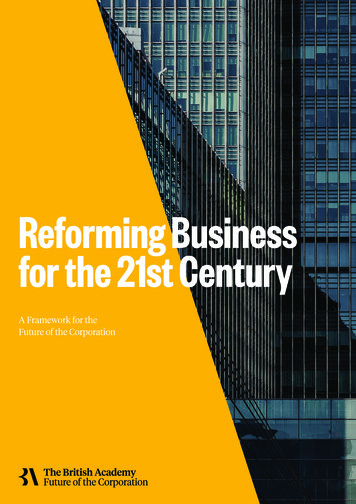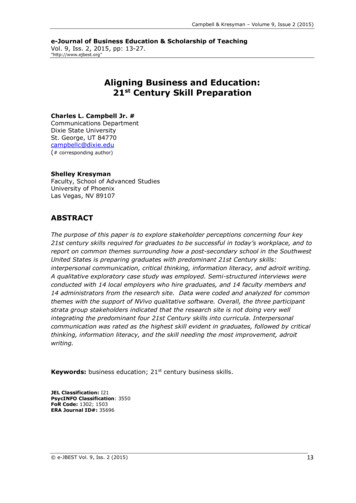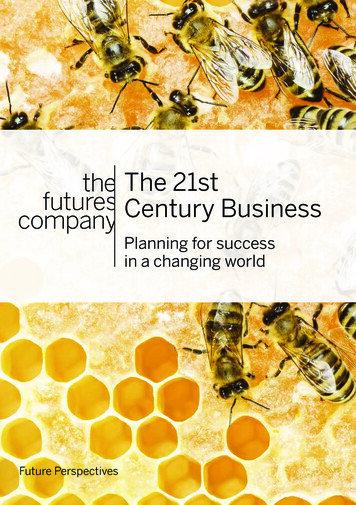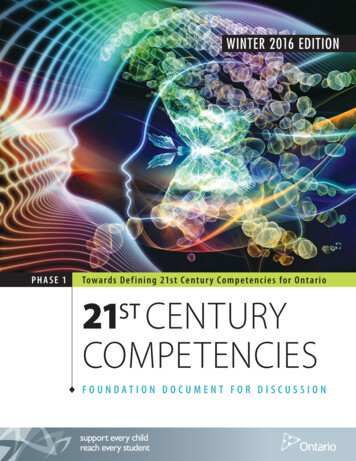
Transcription
Reforming Business for the 21st CenturyReforming Businessfor the 21st CenturyA Framework for theFuture of the Corporation1
Future of the Corporation3
Reforming Business for the 21st CenturyPrefaceProfessor Sir David CannadineAs an historian, the future may not be natural territory. Yet the future of the corporationstarts with its history, and the corporation has a history of being a remarkable instrumentfor bringing people together to commit to a collective endeavour.This report from the British Academy sets out a new framework for business in the 21stcentury, drawing on the finest minds in the UK and beyond. It is the first in our serieson the Future of the Corporation; a programme which aims to contribute to redefiningbusiness in the 21st century and building trust between business and society.The ambition of the Future of the Corporation programme reflects not only the scale ofthe issues it addresses but also its method to answer them. Far from being a narrow lookat the corporation, it draws on disciplines across the Humanities and Social Sciences –demonstrating the value of these subjects in understanding the past, making sense of thepresent and extrapolating to the future.It also exploits the British Academy’s convening power in the field of business and policyto engage leading thinkers in business and government in ensuring the relevance of ourresearch for business practice and public policy.This work is vital now because of people’s concerns about rising inequality, increasingglobalisation, declining trust and the impact that new technologies will have onemployment. Business and government have sought different solutions to thesechallenges, but alone these solutions have been found wanting.Through this programme, The British Academy has started a debate on the way in whichbusiness will be conceived, managed and regulated over the coming decades. We arecommitted to this dialogue, but we cannot do it alone. It will be a hard road that requiresleadership, audacity and clear-sightedness about the challenges ahead. So we call on allbusiness leaders, politicians, civil society actors and fellow academics to take note andjoin us in collectively working out the solutions.Professor Sir David CannadineFBA FRSL FSA FRHistSPresident, The British Academy3
Reforming Business for the 21st CenturyForewordA radical reformulation of the concept of the firmThe Future of the Corporation is one of the most ambitious programmes of research tohave been undertaken to date on the current state and future prospects of business. Itsremit is to consider the implications of economic, environmental, political and socialchallenges, and scientific and technological opportunities for the future developmentof business. It is organised by the British Academy, the UK’s national body for thehumanities and the social sciences.31 academics from the humanities and social sciences have been participating in the firststage of the programme. Guidance from 25 business leaders has grounded this researchin practice. What emerges is a profoundly novel and insightful perspective on businessthat lays the foundation for a radical reformulation of the concept of the firm. While the13 projects were undertaken independently by people from a diverse range of academicdisciplines from institutions in different parts of the world, the conclusions of theirpapers demonstrate a consistency of thought and a coherent view of how business shouldadapt and respond to the challenges and opportunities it faces.What this report seeks to do is draw together the substantial body of knowledge andinsights that the thirteen research projects provide on the current challenges thatconfront businesses, governments and societies around the world. While setting outkey principles for the future of the corporation, the report is primarily diagnostic inidentifying the nature and source of the problems rather than prescriptive in proposingdetailed policy recommendations. These will be the focus of phase two of the researchprogramme, which will start in 2019.Professor Colin MayerCBE FBAAcademic Lead, Future of the Corporation Programme and Peter Moores Professor ofManagement Studies, Saïd Business School, University of Oxford5
6
Reforming Business for the 21st CenturyContentsPreface3Foreword5Executive summary8Introduction10Part 1: The case for change12A basis in history for corporate purpose14Accelerating and disruptive technological change15Part 2: A framework for business in the 21st Century16Defining and aligning a corporation’s purposes16Embedding a commitment to trustworthiness17An enabling culture19Part 3: The levers of change20Ensuring owners play their part20Improving corporate governance frameworks20Making regulation work22Reforming corporate taxation23Reframing investment around a corporation’s purposes23ConclusionsList of contributing papersAcknowledgements2426287
Future of the CorporationExecutive summary8 Corporations were originally established with clear public purposes. It is only overthe last half century that corporate purpose has come to be equated solely with profit.This has been damaging for corporations’ role in society, trust in business and theimpact that business has had on the environment, inequality and social cohesion.In addition, globalisation and technological advances are exacerbating problems ofregulatory lag. Together, these issues are intensifying the need for a reconceptualisation of thecorporation around purpose. The Future of the Corporation programme representsthe most comprehensive attempt to date to provide this reconceptualisation. Ourresearch suggests a need to develop a new framework for the corporation aroundthree interconnected principles. The first is well-defined and aligned purposes. Corporate purpose is the reason whya corporation exists, what it seeks to do and what it aspires to become. Profit is aproduct of the corporate purpose. It is not the corporate purpose. In some, but by nomeans all cases, corporate purposes should include public purposes that relate to thefirm’s wider contribution to public interests and societal goals. The second principle is a commitment to trustworthiness. When corporationscommit to purposes, they commit to the various parties that are involved in thedelivery of those purposes and vice-versa. This creates reciprocal benefits for thefirm, its stakeholders and society. These arrangements rely on relations of trust. The third principle is embedding an enabling culture. The trustworthiness of anorganisation is reliant on clearly articulated values that are adopted consistently inthe culture of the corporation. Achieving a shift to this new framework will require coordinated action usingfive levers. First is ownership. Corporate ownership is currently equated withshareholders. Instead it should be associated with defining and implementingcorporate purpose. The rights and responsibilities associated with corporate purposeshould replace property right views of ownership. Different types of owners are suitedto different types of corporate purposes and activities. This points to the need fordiversity in corporate ownership. The second lever is corporate governance. Corporate governance is currentlyassociated with aligning the interests of management and shareholders. Instead itshould be linked to the implementation of corporate purposes. Boards cannot controlsome of the largest risks relating to globalisation, the environment and technology.New performance measures are needed for executives to ensure conformity ofcorporations’ activities and investments with their purposes. The third lever is regulation. The notion that competition, regulation andtaxation are sufficient to align the interests of business with society is no longertenable. Technology is intensifying the problem of regulatory lag. One concreteproposal in this regard is to promote ‘forward compliance’. More generally, afundamental overhaul of regulation is required that encourages companies whichperform significant social functions to incorporate public purposes in their corporatepurposes.
Reforming Business for the 21st Century Fourth is taxation. Globalisation has eroded the corporate tax base by allowingcorporations to arbitrage tax domiciles and transfer liabilities to lowest taxjurisdictions. Our research paper identifies and debates the main reforms that arecurrently discussed. However, none of these are without their problems, pointing tothe need for a closer association of corporate with public purposes in determinationof fair levels of taxation. The final lever is investment. Public as well as private investment is required todeliver large-scale, long-term infrastructure investments. Attempts to achieve thisthrough privatisations, public-private partnerships and private finance initiativeshave often been disappointing. It is in precisely these areas, where corporationsperform important public and social functions, that private and public purposesneed to be aligned through the adoption of public purposes in corporate charters andarticles of association. Together these five levers of ownership, governance, regulation, taxation andinvestment offer the opportunity of promoting corporate and public purposes aroundtrustworthy organisations with enabling cultures of integrity.BelowThere is a need for areconceptualisation of thecorporation around threeinterconnected principles:purpose, trustworthinessand culture.9
Future of the CorporationIntroductionThe bond between the corporation and its public purposehas waxed and waned since corporations were first establishednearly two millennia ago.This has happened in response to socio-economic and geopolitical shifts, but thecorporation’s foundations remained embedded in delivering public purposes alongsidecommercial functions. It is only over the last half-century that the sharp intensification ofthe profit motive has occurred. It came as markets for corporate control emerged to fill thevacuum in corporate governance created by growing dispersion of ownership.In 1962, Milton Friedman set out a framework for business in which he described thesocial responsibility of businesses as being to increase profits so long as they stay withinthe rules of the game. It was a powerful and influential proposition that establishedthe conventional framework for business around the world. However, it has seriousdeficiencies and is no longer tenable as a framework for business in the 21st century. Ithas been the source of growing disaffection with business, its environmental, social andpolitical problems, and the erosion of trust in it. Those problems will intensify in thefuture as technological advances risk exacerbating social detriments as well as benefits ofcorporations, and public policy responses lag increasingly far behind innovations.There is an urgent need for reformIn response, the British Academy has brought together leading academics and businessstakeholders under an ambitious programme to redefine the future of business in the 21stcentury. The programme is grounded in an academic research and steered by practicalinsights from the business community. It began in 2016 when a Steering Group and aCorporate Advisory Group of business leaders were established to advise the programme.A set of interviews with business leaders was commissioned and published as “The Voiceof Business” in 2017 and this, together with a series of events, assisted in the design of thephase one research around ten specific themes: history, purpose, trust, culture, technology,law, regulation and taxation, corporate governance, ownership, investment and socialbenefits. Thirteen groups of academics were then commissioned to explore these themesdrawing on the best available existing evidence. They reviewed existing literatures,analysed them and developed new thinking on the themes. The thirteen papers are listed atthe end of the report and many of them will be published in a special edition of the Journalof the British Academy. This report collects the findings together in a single narrative anddraws out initial conclusions and policy implications which will inform the next stage of theprogramme.What the research and the subsequent synthesis has found is that the proposition thatthe purpose of business is to increase its profit, with the rules of the game preventingexcesses, is not sufficient for the 21st century. The new framework for the corporationwe present in this report calls for a reinterpretation and integration of three principles:a redefining of corporate purpose that is distinct from shareholder returns, anestablishment of trustworthiness founded on norms of integrity, and the embedding of aculture in organisations that enables both.Corporate purposes are the reasons a corporation is created and exists, what it seeksto do and what it aspires to become. They reflect the contribution it wishes to make in10
Reforming Business for the 21st Centuryfurthering the interests of its customers, communities and societies and they are thebasis on which relations of trust are created in business. They are distinct from theconsequential implications for the corporation's profitability and shareholder returns.All corporate purposes should be intrinsic in the sense that they are core to the businessand not just driven by shareholder interests. A close alignment and observance of publicinterests in corporate purpose is particularly relevant to some companies that performimportant social functions, such as utilities.Trust relations in business are created on the basis of corporate purposes. Whencorporations commit to corporate purposes, they commit to the various parties that areinvolved in their delivery and vice-versa. This creates reciprocal benefits for the firm, itsstakeholders and society at large.The trustworthiness of an organisation is an attribute dependent on cultural normsthat promote high levels of integrity. It is reliant on clearly articulated values that areadopted consistently throughout the organisation. Ethical motivations of owners, boards,managers and employees are necessary to build trustworthiness in relation to customersand other stakeholders. There is a particular duty on corporations to demonstratetrustworthiness where there is a dependency of others on it, or incapacity to avoid theconsequences of its violation.Trustworthy behaviour and corporate purpose must be enabled by a culture of honesty,integrity and other-regarding interests within the firm. It should be promoted by theleadership and embedded consistently throughout the corporation. It may be supportedby external regulatory requirements but the ability of external parties to provide effectiveregulation is being eroded, particularly by the accelerating pace of technological advances.We examine five levers that government and business may use to bring about the shifttowards the new framework: ownership, corporate governance, regulation, taxation andinvestment.Owners of corporations have a profound influence on the promotion of corporatepurposes. However, they have not exercised that influence sufficiently. The ownership ofcorporations is currently associated with shareholdings and the attribution of shareholderrights with property rights of shareholdings. Instead, ownership should primarily berelated to the formulation and implementation of corporate purposes.Corporate governance is at present primarily concerned with aligning managerialinterests with those of shareholders. But it should be recognised as the means by whichcorporate purposes are implemented by management in the organisation. The particularform that corporate governance takes will therefore be specific to the nature of the firm’scorporate purposes and the particular requirements to deliver them.The notion that regulation and taxation are sufficient to align the interests of businesswith society is no longer tenable. Technological advances are lengthening the lag ofregulation behind the innovatory processes and products that corporations are adopting.This is intensifying the failure of policy to correct the detriments created by corporationsmotivated predominantly by a profit purpose. Instead regulation should be seeking toalign corporate with public purposes in those organisations and circumstances where it ismost relevant because of the social function performed by corporations.Globalisation is intensifying the inability of nation states to use corporate taxation as asource of public revenue. Attempts to rectify this through alterations to the structure ofcorporate taxation have not been successful to date. This reflects a failure of corporationsto recognise and respond to their dependence on societies and nation states through11
Future of the Corporationincluding payment of fair shares of taxes in their corporate purposes.The provision of large scale, long-term investment involves the participation ofgovernment as well as the private sector. The performance of privatisations andpartnerships between the public and private sector in their delivery has often beendisappointing. It is in precisely these areas where corporations are performing significantpublic and social functions that corporate purposes should be aligned with publicpurposes by incorporating the latter in the charters and articles of association of theformer.The five policy levers of ownership, governance, regulation, taxation and investment offerthe opportunity of reconceptualising corporations of the 21st century within a frameworkof defined corporate purposes and a commitment to trustworthiness enabled by corporateculture.This report makes the case for change in part 1 and elaborates on the three principles ofthe new framework in part 2. Part 3 examines each of the five levers for change beforeconcluding and describing the next steps for the Future of the Corporation programme.12
Reforming Business for the 21st Century1: The case for changeThere is a strong and growing ambition to reconsider andreinterpret the nature of the corporation, especially in termsof enabling better alignment between business and publicinterests. History tells us there is nothing radical in thisand demonstrates that it has been commonplace in manymanifestations of the corporate form.1Tensions caused by technology and evolving corporate forms are not new either.Technology is once again the driving force behind the need for an evolution in thecorporate form. Increasing technological change is pushing corporations to adaptbusiness models and management practices in order to survive. But institutions andregulations are adapting too slowly and the situation calls for a robust new framework forbusiness that recognises the importance of both corporate and public interests.2AboveThe Code of Hammurabi inBabylonia represented the firstwritten attempt to regulatecommercial matters.12Davoudi, L., McKenna, C. & Olegario, R. (2018), ‘The Historical Role of the Corporation in Society’, Journal of the British Academy, 6(s1)Hsieh, N., Meyer, M., Rodin, D. & van’t Klooster, J. (2018), ‘The Social Purpose of Corporations: A Literature Review and Research Agenda’,Pending Publication13
Future of the CorporationA basis in history for corporate purposeThroughout its 4,000-year history from the Code of Hammurabi in Babylonia, throughthe Roman Republic to the East India Company and the Industrial Revolution, businessenterprise has been motivated by a strong element of public purpose.3 The corporationwas established In Roman Law to perform public functions of minting coins, collectingtaxes, looking after public buildings and undertaking public works. It was then used inthe governance of municipalities in Europe, the creation of the first universities and theestablishment of the Roman Catholic Church.The corporation was also the basis of the emergence of the merchant trading companies, mostnotably the East India Company, and then the companies that built the railroads and canals. Withfreedom of incorporation in the 19th century came the private company, which was the backboneof the rise of manufacturing industry, service companies and transnational corporations.It is only over the last 60 years that the drive to equate corporate purpose with increasingprofit has become so acute. This has resulted from the emergence of markets in corporatecontrol – the takeover market — in the 1950s and more recently hedge fund activism. Itwas encapsulated in what became the conventional conceptualisation of the corporationin modern times – the Friedman Doctrine, as first described in Milton Friedman’s bookCapitalism and Freedom in 1962 — that “the one and only social responsibility of business isto use its resources and engage in activities designed to increase its profits so long as it stayswithin the rules of the game”.4 It is the basis of business education and practice and theformulation of laws and regulation towards business around the world.The reason why this happened was the changing nature of ownership of corporationsthat occurred through the 20th century and the consequence of this for their governance.After freedom of incorporation was first introduced in the 19th century, families andfounders were initially the owners of predominantly private companies. However, duringthe first half of the 20th century ownership became increasingly dispersed in the handsof first individual and then institutional shareholders, such as life insurance companies,pension funds and mutual funds.This created a problem of the separation of ownership of companies from theirmanagement and the concern described by Berle and Means that large corporations wereincreasingly being run by management that was accountable to no one.5 The response wasa focus on how to align the interests of management with those of shareholders throughincentives and markets for corporate control.It is at this point that our research suggests the nature of the corporation erred.6 While itwas right to be concerned about the lack of accountability of management, it was wrongto see its resolution in control by one party to the firm. The reason why this happenedwas that the rights of shareholders were equated with the property rights of owners.Shareholders bore the risks and rewards of the success and failure of business and so hadcorresponding rights to control it.But shareholders are not in many cases owners in any meaningful sense of the wordand do not aspire to act as owners. This misconception and preoccupation with onesingle party to the firm rather than a wider constituency has been the cause of mounting345614This section primarily summarises findings from Davoudi, L., McKenna, C. & Olegario, R. (2018), ‘The Historical Role of the Corporation inSociety’, Journal of the British Academy, 6(s1)Friedman, M. (1962) Capitalism and Freedom, The University of Chicago PressBerle, A. and Means, G. (1932), The Modern Corporation and Private Property, New York: Harcourt, Brace & WorldDavoudi, L., McKenna, C. & Olegario, R. (2018), ‘The Historical Role of the Corporation in Society’, Journal of the British Academy, 6(s1)
Reforming Business for the 21st Centuryenvironmental concerns, social tensions and political backlash. These have becomeparticularly acute since the 2007–8 Financial Crisis, as many of the defects of theconventional wisdom were laid bare.The case for change does not only come from looking backwards at the origins of thecorporation and its original foundation in public purpose, but more significantly fromlooking forward to the forces that are shaping the corporation of the future.Accelerating and disruptive technological changeDisruptive innovation has always been part of the corporate landscape.7 The IndustrialRevolution marked the demise of many institutions, corporate structures, labour practices,social and political norms and laws, but the birth of others. That continuing process ofrenewal raises complex and inter-linked economic, social and political questions.8Technological innovation has, in large part, driven globalisation, prompting growingtensions between digitally skilled, location-agnostic commercial corporations and theconstraints of nation-based political and legal systems.9 More specifically, the digital ageis bypassing traditional authorities and changing the world of work.10 Smart technologiesare global, networked, intuitive, learning and automated. They rely heavily on trust andtrustworthiness of all participants and transform how people and corporations relateto each other. Amongst the most disruptive innovations are artificial intelligence (AI),blockchain, quantum computing and 3D printing, but there are others not yet formedor publicised.11 Such technologies, many based on data mining and manipulation,are already impacting economic activity, from new ‘clean’ energy to personalcommunications, medicine and bio-engineering.12Recent analysis suggests that technological innovation may increase incremental profitsfor first movers, but also reduce innovation incentives for laggards.13 What is alreadyclear is that the world’s highest value corporations are based around digital ecosystems.14Cloud-based, platform businesses rely on global networks of connectivity of bothproducers and consumers, rather than the single-location, hierarchical, linear structuresof the past. The CEOs and board members of the future may have to be as adept at theselection of high-quality algorithms as they are at the management of staff.The rate of technological change appears to be increasing over time and becoming lesspredictable.15 The pace of change exceeds the ability of policy makers and regulators torespond to it. Instead business itself needs to be better placed to manage it with a greaterclarity of purpose and an enabling culture to accommodate it.789101112131415‘Disruptive innovation’ was coined by Bower, J. L. & Christensen, C. M. (1995), Disruptive Technologies: Catching the Wave, HarvardBusiness Review, January–February 1995This section primarily summarises findings from Armour, J., Enriques, L., Ezrachi, A. & Vella, J. (2018), ‘Regulation and Law: The Role ofCorporate, Competition and Tax Law’, Journal of the British Academy, 6(s1), Birkinshaw, J. (2018), ‘How is Technological Change Affectingthe Nature of the Corporation?’, Journal of the British Academy, 6(s1) and Belenzon, S., Hamdani, A., Kandel, E., Hashai, N. & Yafeh, Y.(2018), ‘Technological Progress and the Future of the Corporation’, Journal of the British Academy, 6(s1). Any assertions or findingspresented which are more specific are referenced separately.Belenzon, S., Hamdani, A., Kandel, E., Hashai, N. & Yafeh, Y. (2018), ‘Technological Progress and the Future of the Corporation’, Journal ofthe British Academy, 6(s1)The British Academy and The Royal Society (2018) The impact of artificial intelligence on workBelenzon, S., Hamdani, A., Kandel, E., Hashai, N. & Yafeh, Y. (2018), ‘Technological Progress and the Future of the Corporation’, Journal ofthe British Academy, 6(s1)Ibid.Armour, J., Enriques, L., Ezrachi, A. & Vella, J. (2018), ‘Regulation and Law: The Role of Corporate, Competition and Tax Law’, Journal of theBritish Academy, 6(s1)Birkinshaw, J. (2018), ‘How is Technological Change Affecting the Nature of the Corporation?’, Journal of the British Academy, 6(s1)Belenzon, S., Hamdani, A., Kandel, E., Hashai, N. & Yafeh, Y. (2018), ‘Technological Progress and the Future of the Corporation’, Journal ofthe British Academy, 6(s1)15
Future of the Corporation2: A framework for businessin the 21st CenturyThe synthesis of the ten themes covered by our researchhas brought out three principles which could help in thedevelopment of a new framework for the future of thecorporation: corporate purpose, trust and culture.A corporation must have a set of clearly defined and aligned purposes — the goals itactively pursues and its contributions to societal goals or public interests. These shouldbe complemented by an inherent commitment to trustworthiness and supported by anenabling organisational culture. The key features of this framework are that it integratesthese three principles and requires corporations to take account of a range of stakeholders.Defining and aligning a corporation’s purposesCorporate purpose is the reason a corporation is created and exists, what it seeks to doand what it aspires to become.16 It reflects the contribution it wishes to make in furtheringthe interests of its customers, communities and societies and is the basis on whichrelations of trust are created in business.17Corporate purpose is distinct from the consequential implications for the corporation'sprofitability and shareholder returns.18 The purpose of corporations is not to produceprofits. The purpose of corporations is to produce profitable solutions for the problems ofpeople and planet. In the process it produces profits, but profits are not per se the purposeof corporations.That distinction is fundamental and its confusion in the Friedman Doctrine has beenthe source of many of the defects of current business practice and policy.19 All corporatepurposes should be intrinsic in the sense that they are core to the businesses and not justdriven by shareholder interests.On the other side of the coin, corporate purpose is sometimes automatically equatedwith public purpose — the revealed preferences of societies and the public.20 There aresome circumstances in which the purposes of corporations should indeed be equatedwith those of the public interest. For example, a close alignment and observance of publicinterests in corporate purpose is particularly relevant to some companies that performimportant social functions, such as utilities. However, other corporations should be able161718192016This section primarily summarises findings from Hsieh, N., Meyer, M., Rodin, D. & van’t Klooster, J. (2018), ‘The Social Purpose ofCorporations: A Literature Review
This report from the British Academy sets out a new framework for business in the 21st century, drawing on the finest minds in the UK and beyond. It is the first in our series on the Future of the Corporation; a programme which aims to contribute to redefining business in the 21st century and building trust between business and society.










